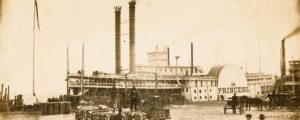When Col. Paul Tibbets flew over Wendover Field in September 1944 in search of a remote, secure place where he could train the B-29 crews he handpicked to drop the atomic bomb, he looked down from thirty thousand feet and declared it “perfect.”
Others didn’t quite share his enthusiasm. The comedian Bob Hope came through on a USO tour and wise-crackingly dubbed the army air base “Leftover Field.” Hugging the edge of the Bonneville Salt Flats 125 miles west of Salt Lake City, Wendover was as bleak and barren as a bleak and barren desert could be. A few stark brown hills offered the only relief from the mirage-laden salt plains that stretched out as far as the eye could see.
The town itself, boasting a population of one hundred before the air force arrived in 1940, owed its existence to a small water tower that refilled steam locomotives of the Western Pacific Railroad, a few arsenic mines, and the State Line Hotel. The hotel spanned the Utah/Nevada border, luring travelers on two-lane U.S. Route 40 with a lone light atop a tall pole, a gas station, and the promise of hamburgers in the café on the Utah side of the building and gambling and liquor on the Nevada side.
Sixty-four years later, the desert—and Wendover—is as stark as ever. Several bizarrely glitzy high-rise casinos have arisen on the Nevada side of town in the last couple of decades, but the sense of isolation and remoteness still dominates. That isolation has a silver lining: today Wendover Field is the best-preserved bomber training base from World War II. Some 100 of its 668 original buildings are still standing. Many remnants of the ultra secret mission for which Tibbets’s men trained are still here to be seen, touched, and experienced.
Interstate 80, with a 75 mph speed limit, has replaced old U.S. 40 and cut the drive from Salt Lake City in half from the three hours it took during World War II. But the bleak desert scenery is virtually unchanged from what it was then, or for that matter from what it was a century and a half ago, when a single emigrant wagon train decided to try this route to California, an act of folly never repeated.
They don’t call them salt flats for nothing. An information sheet I picked up at the West Wendover Welcome Center in Nevada informed me that they are so flat you can actually see the curvature of the earth if you stand at the right spot. Back in the ’80s, a slightly eccentric Iranian-born Swedish artist decided the drive was so boring that, to relieve the monotony, he erected at his own expense—reputed to be $1 million—a crazy sculpture in the empty stretch about thirty miles east of Wendover; the “Tree of Utah” looks like a Christmas tree made of steel I-beams and huge fuzzy baseballs. It somehow seems to fit.
From the Wendover strip, the short road to the airfield (on the much poorer Utah side, where many of the casino workers live) goes past a dreary row of shanties, a sign for “Painless Pete’s” dentist office, and the old airfield chapel, now converted into an apartment building.
That anything from the World War II era is left standing at Wendover Field is due to a combination of arid climate, benign neglect, dumb luck, and recent ardent efforts of preservationists. By 1943 the population of sleepy Wendover had exploded to nineteen thousand five hundred as the field trained more heavy bomber crews than any other base in the world. With 320 days a year of clear skies and 3.5 million acres of government land, the site offered perfect flying weather and ample room for bombing practice. But when the war ended, the field was effectively put in mothballs and Wendover’s population plummeted back to five hundred. The air force sold off hundreds of buildings for lumber or scrap.
Yet remarkably, all but one of the war era hangars, the original steel-ladder control tower and wood-frame operations building, the cottage-like clapboard squadron briefing rooms, the officers’ club with its broad dance floor and balcony, even the secret huts and barbed wire fences of the “Technical Site” where the mockup atomic bombs were assembled and readied for the bomber crews, remain.
In 1977 the air force deeded the field to the city of Wendover, Utah; in 1998 it was handed over to the county of Tooele, Utah. That was when James Petersen, the county’s aviation director, found himself astonished at the neglected historic treasure that had fallen into his lap. “When I came, these hangars were just junk piles,” he told me as we walked along a war-era concrete ramp pocked with retaining rings for the scores of B-17s and B-24s that once crowded side by side. “Nobody cared anything about anything. We hauled off seventy-five or eighty huge dump truck loads of trash.”
A few abortive attempts by the city to pull in revenue had left a more melancholy legacy: a local drag racing club occupied one of the World War II–era taxiways; a salt miner leased one of the hangars and left it in a miserably dilapidated state, with old sinks and a huge coal-fired boiler peering through a broken wall; a Hollywood crew filming the sci-fi thriller The Philadelphia Experiment back in the ’80s asked if they could burn down one of the hangars for a scene, and the town said sure.
Petersen founded a nonprofit group, Historic Wendover Airfield, to raise money to restore the historic structures and raise awareness of the momentous events that took place here. With help from the flush casinos, he has already restored one of the old squadron operations buildings to serve as a commercial air terminal, which currently brings in fifty thousand visitors a year on casino charter flights. He installed black-and-white tile floors and light fixtures from the war era, and preserved odd reminders of the field’s history—such as a huge concrete safe, which sits in one corner of the passenger lounge.
Out in the middle of the field, a concrete pit built to load versions of the five-ton “Fat Man” bomb into B-29s was excavated by a Boy Scout troop a few years ago. (They found forty live .50-caliber machine gun bullets in the layers of mud in the process.) In one building on the flight line, a row of massive steel doors with combination locks guards the vaults where the secret Norden bombsights were kept. A huge bunker, used to align the B-17s’ guns, stands in silent vigil at the end of the original field’s crisscrossing runways.
Tibbets’s crews trained relentlessly at Wendover. So did the ground crews who assembled the bombs. None were ever let in on the secret of what the mission was, though at least a few who had science backgrounds guessed it had something to do with atomic energy. In the skies over Wendover, the aircrews practiced over and over the maneuver Tibbets had devised to shield the planes from the blast of the A bombs—a 155-degree diving turn immediately after releasing the bomb. They also carried out a series of experiments to refine the ballistics of the bombs and make sure their complex fusing electronics worked.
Pushing open the huge door of the rusting hangar that housed the Enola Gay and the other B-29s specially modified to carry out the atomic mission, Petersen described to me his “optimistic vision” for the site. With a $75,000 grant from the National Park Service, the airfield has recently drawn up a restoration plan. The next step is to raise the necessary $5 million. Petersen hopes the Enola Gay hangar will be the centerpiece, with aircraft displays and a theater. “Most aircraft museums are in new buildings,” he says. “But this is the original location, the original setting—this is where the guys were that dropped the bomb that changed the twentieth century.”
Originally published in the September 2008 issue of World War II Magazine. To subscribe, click here.




